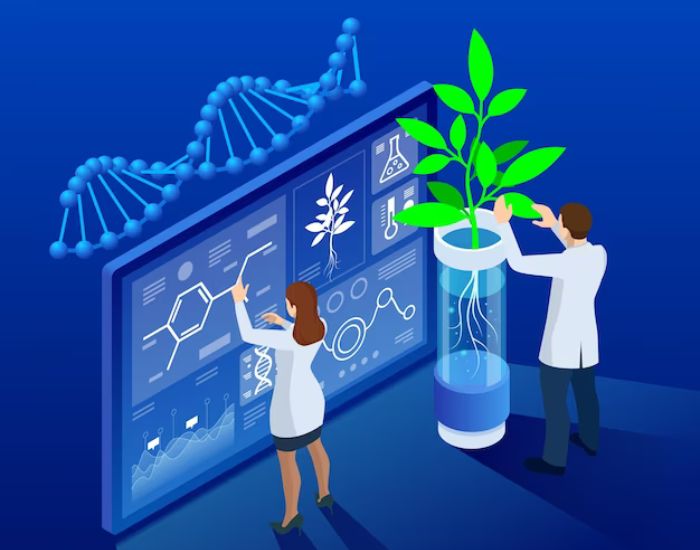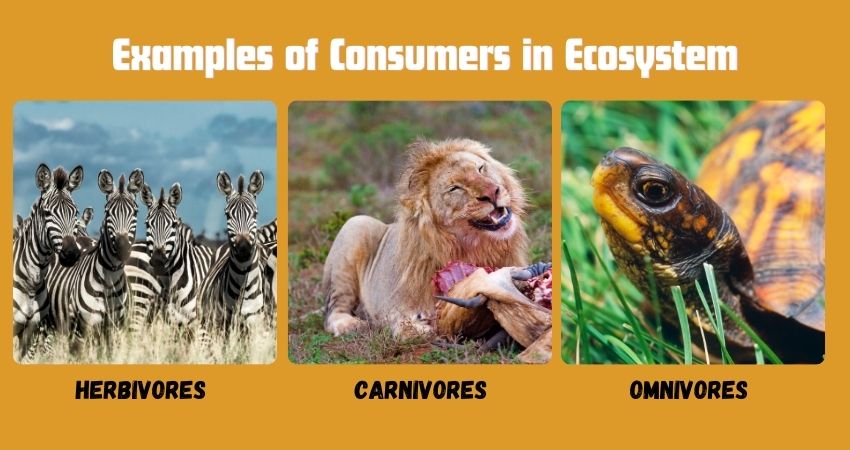In an ecosystem, every living organism has a significant role to play. Producers can create their own food, but consumers cannot. They must depend on the energy stored within other living things. Consumers come in various shapes and sizes, ranging from small insects to large predators. Each consumer has a unique ecological niche, which they fill. This blog post explores 20 interesting examples of consumers from different ecosystems. It highlights their dietary habits and roles within their respective environments.
Examples of Consumers in Ecosystem
Here are 20 examples of consumers in an ecosystem:
1. Herbivores – The Salad Lovers
Herbivores are the plant-based enthusiasts of the animal kingdom. From towering giraffes munching on acacia leaves to cute rabbits nibbling on clover, these creatures sustain themselves by feasting on vegetation. Whether it’s the majestic elephant or the gentle cow, herbivores play a crucial role in maintaining the green balance of ecosystems.
2. Carnivores – The Meat Connoisseurs
Carnivores are the hunters and predators of the wild, showcasing a diverse range of hunting techniques. From the stealthy lion stalking its prey on the savannah to the powerful orca dominating the oceans, these meat connoisseurs keep herbivore populations in check and maintain the delicate equilibrium of the food chain.
3. Omnivores – The Buffet Enthusiasts
Omnivores are nature’s flexible eaters, indulging in both plant and animal matter. Bears are a classic example, relishing berries and fish alike. Humans also fall into this category, showcasing the ability to enjoy a diverse menu ranging from fruits and vegetables to meats and sweets.
4. Insectivores – The Tiny Treat Tasters
Insectivores are the bug aficionados of the animal kingdom. From agile birds like the warbler catching insects mid-flight to the charismatic anteater feasting on ants with its long tongue, these creatures help control insect populations, preventing them from becoming pests.
5. Frugivores – The Fruit Fanatics
Frugivores are fruit specialists, relishing the natural sweetness of fruits and berries. Bats and certain primates, like the capuchin monkey, are avid frugivores, contributing to seed dispersal as they enjoy their fruity feasts.
6. Detritivores – The Cleanup Crew
Detritivores are the unsung heroes of the ecosystem, feeding on decaying organic matter. Creatures like dung beetles and vultures play a vital role in recycling nutrients by turning dead organisms into valuable resources, maintaining the cycle of life.
7. Scavengers – The Thrift Store Shoppers
Scavengers are opportunistic eaters, making the most of what others leave behind. Hyenas and vultures are classic scavengers, ensuring that the remains of a predator’s meal don’t go to waste.
8. Filter Feeders – The Soup Sippers
Filter feeders are aquatic organisms that sift tiny particles from water to satisfy their nutritional needs. Whales, baleen sharks, and certain types of clams are examples of filter feeders, turning the ocean into a vast, living soup kitchen.
9. Grazers – The Lawn Mowers of Nature
Grazers are the landscapers of terrestrial ecosystems, keeping vegetation in check by feeding on grasses and low-lying plants. Bison, zebras, and wildebeests are prime examples, creating open spaces that benefit both themselves and the plants they graze upon.
10. Browsers – The Window Shoppers
Browsers are selective herbivores that delicately nibble on leaves and twigs. Giraffes elegantly reach high into trees to satisfy their browsing tendencies, showcasing a refined dining style in the animal kingdom.

11. Parasites – The Freeloaders
Parasites are organisms that thrive at the expense of other organisms. Examples include ticks, tapeworms, and leeches. These freeloaders may not contribute much to their host’s well-being, but they play a role in the complex web of interdependence in ecosystems.
12. Mycophagists – The Mushroom Munchers
Mycophagists are creatures that enjoy a fungal feast. From insects like the fungus beetle to larger mammals like the wild boar, these mushroom enthusiasts contribute to the decomposition of organic matter, playing a vital role in nutrient cycling.
13. Nectarivores – The Sweet Tooth Crew
Nectarivores are creatures that primarily feed on the sweet nectar of flowers. Hummingbirds, bats, and certain insects like bees and butterflies are members of this sweet-toothed crew, aiding in pollination as they indulge in floral delights.
14. Granivores – The Seed Snackers
Granivores are seed specialists, playing a crucial role in plant reproduction by dispersing seeds. Birds like finches and sparrows, as well as rodents like squirrels, are prolific seed snackers, ensuring the survival and spread of plant species.
15. Planktivores – The Tiny Snack Seekers
Planktivores are aquatic organisms that feed on plankton, microscopic organisms floating in water. Fish like herring and baleen whales are examples of planktivores, contributing to the health of marine ecosystems by sustaining themselves on these tiny snacks.
16. Folivores – The Leaf Lovers
Folivores are specialized herbivores that primarily consume leaves. Koalas, caterpillars, and certain reptiles are avid leaf lovers, demonstrating a unique adaptation to a diet rich in plant foliage.
17. Molluscivores – The Shellfish Savorers
Molluscivores are creatures that feast on mollusks, such as clams, snails, and other shell-bearing organisms. Birds like oystercatchers and certain fish, including the cone snail, showcase a specialized taste for these shelled delights.
18. Planktonivores – The Microscopic Munchers
Planktonivores are tiny organisms that feed on plankton, forming a crucial link in aquatic food chains. From small fish to filter-feeding whales, these microscopic munchers contribute to the biodiversity and balance of marine ecosystems.
19. Trophic Levels – The Food Chain Fanatics
Trophic levels represent the hierarchy of feeding positions in a food chain. From primary producers like plants to apex predators like lions or sharks, each trophic level has its role in the flow of energy through ecosystems, showcasing the intricate relationships among species.
20. Humans – The Ultimate Consumers
Humans, the ultimate consumers, exhibit a remarkable diversity in dietary habits. From omnivorous diets featuring fruits, vegetables, and meats to unique cultural preferences, humans contribute to and impact ecosystems in various ways. Whether cultivating crops or engaging in sustainable practices, our choices play a role in the intricate dance of the natural world.
The intricate web of life in ecosystems is driven by many consumers. By understanding their diverse roles, we can appreciate the delicate balance that sustains the natural world.

